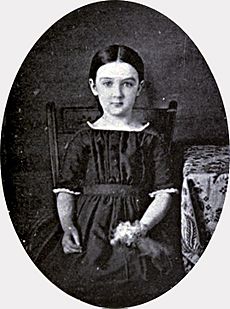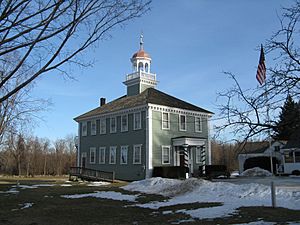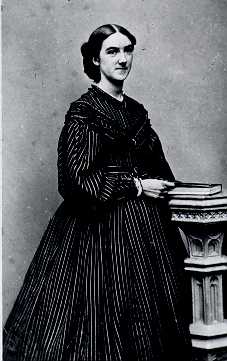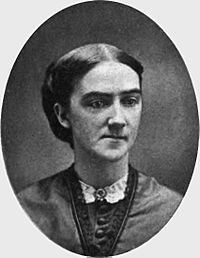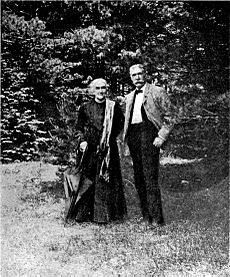Ellen Swallow Richards facts for kids
Quick facts for kids
Ellen H. Swallow Richards
|
|
|---|---|
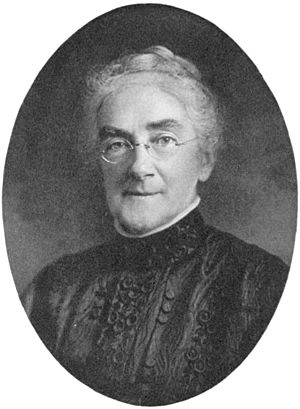
Richards c. 1890s
From The Life of Ellen H. Richards by Caroline L. Hunt, 1912 |
|
| Born | December 3, 1842 Dunstable, Massachusetts, U.S.
|
| Died | March 30, 1911 (aged 68) Boston, Massachusetts, U.S.
|
| Resting place | Christ Church Cemetery, Gardiner, Maine, U.S. |
| Education | |
| Occupation |
|
| Known for | Home economics Euthenics School meals |
| Spouse(s) |
Robert Hallowell Richards
(m. 1875) |
| Signature | |
 |
|
Ellen Henrietta Swallow Richards (born Swallow; December 3, 1842 – March 30, 1911) was an American scientist and university teacher. She was a pioneer in many fields, including safety engineering and environmental chemistry. Her important work in making things clean and safe, and her research into how science could help in the home, created the new field of home economics.
Ellen Richards was the first person to use science to study nutrition. She was also the first woman ever accepted into the Massachusetts Institute of Technology (MIT). She graduated in 1873 and later became MIT's first female instructor. She was also the first American woman to get a degree in chemistry, which she earned from Vassar College in 1870.
Richards believed that the work women did at home was very important for the economy. She thought that science could make homes better and healthier for everyone.
Contents
Her Early Life
Growing Up in Massachusetts
Ellen Richards was born in Dunstable, Massachusetts. She was the only child of Peter and Fanny Swallow. Her parents believed strongly in education, even though they didn't have a lot of money.
Ellen was taught at home when she was very young. In 1859, her family moved to Westford, where she went to Westford Academy. She studied subjects like math, writing, and Latin. Her skill in Latin helped her learn French and German, which was rare at the time. Because she was good at languages, she tutored other students. The money she earned helped her continue her studies.
In 1862, she left the academy. Soon after, she got the measles, which made her sick and delayed her plans to become a teacher.
In 1863, her family moved to Littleton, Massachusetts, where her father bought a bigger store. In 1864, Ellen, at age 21, started teaching.
She didn't teach in 1865 because she was helping in the family store and taking care of her sick mother. In the winter of 1865–66, Ellen studied and attended lectures in Worcester.
Becoming a Scientist
In September 1868, Ellen started at Vassar College. She was first a special student, but later joined the senior class and graduated in 1870. She then earned a Master of Art's degree by studying the chemical makeup of iron ore. Two important teachers who influenced her at Vassar were Maria Mitchell, an astronomer, and Professor Charles S. Farrar, who led the Natural Sciences and Mathematics Department.
In 1870, she wanted to learn more about chemistry. She asked a chemistry company in Boston if she could be an apprentice. They told her to try to get into the Massachusetts Institute of Technology (MIT) as a student instead.
On December 10, 1870, MIT decided to accept Ellen Swallow as a special student in Chemistry. This made her the first woman ever admitted to MIT! However, MIT made it clear that her admission didn't mean other women would automatically be accepted in the future.
In 1873, Ellen received a Bachelor of Science degree from MIT. She continued her studies there and would have been the first to get an advanced degree from MIT, but they didn't want to give this honor to a woman. MIT didn't award its first advanced science degree until 1886.
Ellen Richards later served on the board of trustees for Vassar College for many years. In 1910, she received an honorary doctor of science degree from Vassar.
Marriage and Her Home Lab
On June 4, 1875, Ellen married Robert Hallowell Richards. He was the head of the Mine Engineering Department at MIT. They lived in Jamaica Plain, Massachusetts. With her husband's support, Ellen continued to work with MIT. She volunteered her time and even gave $1,000 each year to the "Woman's Laboratory." In this lab, she taught mostly schoolteachers who wanted to learn about chemistry and minerals.
Her Amazing Career
After college, Ellen Richards worked as an unpaid chemistry lecturer at MIT from 1873 to 1878.

From 1884 until she passed away, Ellen Richards taught at the new sanitary chemistry lab at the Lawrence Experiment Station. This was the first lab of its kind in the United States.
In 1884, she became an instructor in sanitary chemistry at a new MIT lab focused on cleanliness and public health.
Mrs. Richards also worked as a consulting chemist for the Massachusetts State Board of Health from 1872 to 1875. She was the state's official water analyst from 1887 to 1897. She also advised the U.S. Department of Agriculture on nutrition.
Science for a Better Life
Clean Air and Water
In the 1880s, Ellen Richards became very interested in clean air and water. The Massachusetts State Board of Health asked her to test 40,000 samples of local water used for drinking. Her work led to the "Richards' Normal Chlorine Map." This map showed the natural levels of chloride (a chemical found in salt) in the state's water. If water had much higher chloride levels than expected, it likely meant there was human pollution.
Because of her work, Massachusetts set the first water-quality standards in America. The first modern sewage treatment plant was also built in Lowell, Massachusetts.
Studying Rocks and Minerals
Ellen Richards' master's thesis at Vassar was about how much vanadium was in iron ore.
She did many experiments with minerals. She even discovered a part of a rare mineral called samarskite that wouldn't dissolve. Later, other scientists found new elements, samarium and gadolinium, from this discovery. In 1879, she was the first woman to become a member of the American Institute of Mining and Metallurgical Engineers.
Making Homes Healthier
Ellen Richards used her scientific knowledge to improve homes. She believed that since women were often in charge of the home and family nutrition, they should learn about science. She wrote books about science for home use, like The Chemistry of Cooking and Cleaning (1882). Her book Food Materials and Their Adulterations (1885) helped lead to the first Pure Food and Drug Act in Massachusetts.
She even used her own home as a kind of science lab. She changed her heating and cooking from coal and oil to gas to improve air quality. She and her husband put in fans to pull air out of their home, making the air inside cleaner. She also tested the water from their well to make sure it was safe to drink and not polluted by wastewater.
The Science of Euthenics
Richards created the word euthenics. It comes from a Greek word meaning "to be in a flourishing state" or "to prosper."
In her book Euthenics: the science of controllable environment (1910), she explained it as making living conditions better through careful effort. The goal was to help people be more efficient and healthy.
Richards was the first person to use the term euthenics, meaning "the science of better living," in her book The Cost of Shelter (1905).
Working in the Lab
After her first job as a water analyst, Richards started her own business doing sanitary chemistry. She tested water, air, and food. She also tested wallpapers and fabrics for arsenic. In 1878 and 1879, she checked many common groceries for the state. Her findings were published in a report by the Board of Health.
She also advised the Manufacturers Mutual Fire Insurance Company. In 1900, she wrote a textbook called Air, Water, and Food from a Sanitary Standpoint with A. G. Woodman. Her interest in the environment led her to introduce the word ecology into English around 1892. This word was first used by a German biologist to describe the "household of nature."
Richards also wanted to apply scientific ideas to everyday home life, like nutrition, clothing, physical fitness, cleanliness, and managing a home efficiently. This led to the creation of the field of home economics. She published The Chemistry of Cooking and Cleaning: A Manual for House-keepers in 1881. She also designed model kitchens, created study plans, and organized conferences.
Opening Doors for Women
Teaching at the Woman's Lab
In 1875, Mrs. Richards spoke to the Woman's Education Association of Boston. She explained that women needed more opportunities in science. She believed that MIT would provide space for a "Woman's Laboratory" if the Association could raise money for equipment and books.
This led to the creation of the MIT Woman's Laboratory in November 1876. MIT provided a small building, and Mrs. Richards became an unpaid assistant instructor in 1879. She taught chemical analysis, industrial chemistry, mineralogy, and applied biology. The Woman's Education Association raised money for the lab's equipment.
In 1883, MIT built a new building with space for all students, both women and men. The original Woman's Laboratory closed.
In 1884, Mrs. Richards became an Instructor in Sanitary Chemistry at MIT itself. She held this position until her death. Besides her teaching duties, she also acted as the "unofficial" Dean of Women.
Teaching by Mail
In 1876, Mrs. Richards began working with the first American correspondence school, the Society to Encourage Studies at Home. She became an instructor and developed its science department.
In 1886, Richards helped create a new section for the Society called Sanitary Science. At this time, homes were getting new things like water, gas, and electricity, but many housekeepers didn't understand how to use them safely. Richards saw that people needed to learn how to organize a house using scientific principles.
Founding the AAUW
Richards and Marion Talbot were the "founding mothers" of what is now the American Association of University Women (AAUW). In 1881, they invited fifteen other women college graduates to a meeting in Boston. They wanted to create an organization where women who had gone to college could work together to help other women get higher education and find more opportunities. The Association of Collegiate Alumnae (ACA), which later became the AAUW, was officially started in 1882.
Helping Teachers Learn Science
Lucretia Crocker and women's clubs in Boston helped create a "Teachers' School of Science." Ellen Richards and Crocker developed a mineralogy course for teachers. Scientists in Boston volunteered to teach these courses, making it easy for teachers to learn more science.
The New England Kitchen
On January 1, 1890, Richards worked with Mary Hinman Abel to open the New England Kitchen of Boston. They experimented with ways to prepare tasty, nutritious, and inexpensive food for people with less money.
The Rumford Kitchen
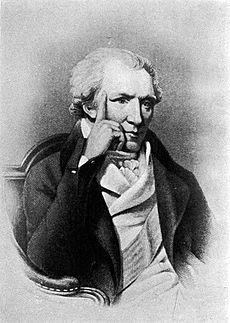
In 1893, Ellen Richards was in charge of the Rumford Kitchen at the World's Fair in Chicago. She also helped arrange an exhibition of the work from the Studies at Home program.
The first "modern" kitchen ranges (stoves) appeared around 1800. They were invented by an American named Sir Benjamin Thompson, also known as Count von Rumford.
School Lunches for Kids
In 1894, a big program started in some Boston high schools. It provided healthy meals at low prices to children who might not otherwise get them. Ellen Richards and Edward Atkinson were key to this program. The New England Kitchen ran it as a "private enterprise" that paid for itself. The program helped provide nutritious meals, which led to similar lunch programs in other cities.
Later, in 1946, President Harry S. Truman signed the National School Lunch Program into law. This program provides low-cost or free school lunch meals to students who qualify.
The Lake Placid Conference
In September 1899, people at the Lake Placid Club in New York decided it was time to bring together those interested in home science, or household economics. They invited many people to the Lake Placid Conference. Melvil Dewey, one of the club's leaders, personally invited Richards. She gave a lecture on living standards and was chosen to lead the conference.
Starting Home Economics
In 1908, Ellen Richards was chosen as the first president of the new American Home Economics Association. This organization was renamed the American Association of Family and Consumer Sciences in 1994. She also started and funded the Association's magazine, the Journal of Home Economics, which began in 1909. It was renamed the Journal of Family and Consumer Sciences in 1994.
Ellen Richards wrote many books about home economics and related topics. Some of her well-known books include Food Materials and their Adulterations (1886), The Chemistry of Cooking and Cleaning, The Cost of Living (1899), Air, Water, and Food (1900), and Euthenics, the Science of Controllable Environment (1910). Many of these books were printed multiple times.
Her Last Days
Ellen Richards passed away on March 30, 1911, at her home in Jamaica Plain, Massachusetts. She had been suffering from angina, a heart condition. She is buried in the family cemetery in Gardiner, Maine.
Her Lasting Impact
|
Ellen Swallow Richards Residence
|
|
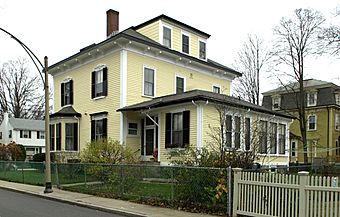 |
|
| Location | 32 Eliot St., Jamaica Plain, Massachusetts |
|---|---|
| Area | 0.2 acres (0.081 ha) |
| Architectural style | Italianate |
| NRHP reference No. | 92001874 |
| Added to NRHP | March 31, 1992 |
- Her home, the Ellen Swallow Richards House, was named a National Historic Landmark in 1992.
- In 1925, Vassar College started a program of euthenics studies, based on Richards' ideas. They built a special hall for it, dedicated in 1929.
- MIT named a room in its main building for female students in her honor. In 1973, on the 100th anniversary of her graduation, MIT created the Ellen Swallow Richards professorship for important female faculty members.
- In 1993, Richards was added to the National Women's Hall of Fame.
- In 2011, she was listed as number eight on the MIT150 list of the top 150 innovators and ideas from MIT. Her work on safe drinking water was highlighted.
- She is honored on the Boston Women's Heritage Trail.
- Swallow Union Elementary School in her hometown of Dunstable, Massachusetts, is named after her.
Books She Wrote
- Richards, Ellen (1898). Food materials and their adulterations. Boston: Home Science Publishing Co. (originally 1885).
- Richards, Ellen (1899). Plain words about food: the Rumford kitchen leaflets 1899. Boston: Home Science Publishing Co.
- Richards, Ellen (1904). First lessons in food and diet. Boston: Whitcomb & Barrows.
- Richards, Ellen (1905). The Cost of Shelter. New York: John Wiley & Sons.
- Richards, Ellen (1906?). Meat and drink. Boston: Health-Education League.
- Richards, Ellen (c.1908). The Efficient worker. Boston: Health-Education League.
- Richards, Ellen (c.1908). Health in labor camps. Boston: Health-Education League.
- Richards, Ellen (1908 or 1909). Tonics and stimulants. Boston: Health-Education League.
- Richards, Ellen, with Alpheus G. Woodman (1909). Air, water, and food: from a sanitary standpoint. New York: John Wiley & Sons. (originally 1900).
- Richards, Ellen (1912). Euthenics: The Science of Controllable Environment : A Plea for Better Conditions As a First Step Toward Higher Human Efficiency. Boston: Whitcomb & Barrows. (originally 1910).
- Sumida, Kazuko, ed. (2007) Collected Works of Ellen H. Swallow Richards. (5 vols.) Tokyo: Edition Synapse.
Where to Find Her Papers
Ellen Richards' original writings and documents are kept in various collections across the United States and other places. Many can be found in collections related to the organizations she worked with, like the American Association of Family and Consumer Sciences.
See also
 In Spanish: Ellen Swallow Richards para niños
In Spanish: Ellen Swallow Richards para niños


